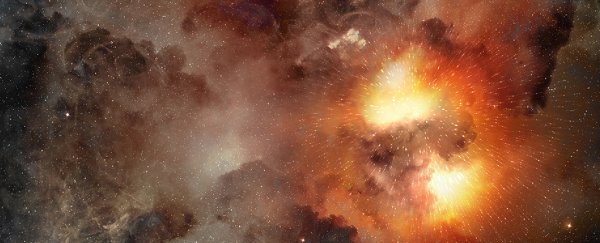Physicists from Eötvös University in Budapest and the Institute for Systems Biology in Seattle have taken an innovative approach to determining when the first organic chemicals formed, and it turns out they could be a lot older than we imagined.
Complex organic chemistry once considered unique to life might not only be ubiquitous throughout the modern Universe - it may have formed a mere cosmic heartbeat after the Big Bang.
Barely a year goes by without the borders of organic chemistry being pushed to new limits. There's carbon chemistry on Mars, alcohol in the veins of baby solar systems, and molecules of aliphatic 'grease' just floating around in between stars.
We've certainly come a long way since chemists Stanley Miller and Harold Urey conducted their famous 'primordial soup' experiment in 1952, showing how a rich variety of amino acids might feasibly form on a newborn planet Earth.
Now we can picture similar amino acids forming in an infant Universe, one that is barely a few million years old.
"The results suggest that the main ingredients of life, such as amino acids, nucleotides and other key molecules, came into existence very early," the group concludes in their report.
Unlike Miller and Urey, the team took a more mathematical approach to determining how elements like carbon, hydrogen, oxygen, and nitrogen could combine into large, complex structures.
For the first 100 million years, the periodic table of the Universe was rather brief: hydrogen, helium, and not a lot else. Baking larger building blocks demanded the gravitational ovens of stars.
This raises an interesting question – once these first stars released their payload of chunky elements, what kinds of compounds did they form?
Theoretically the recipe book would be be close to endless, considering every possible combination of every element in variable numbers.
So the research team put some constraints on the problem, limiting their scope to molecules of a given mass rather than simply atomic configurations. That way molecules of the same mass could be placed in the same basket.
Next they compared this array with Earth's sizeable chemical diversity, using a database consisting of around 94 million molecules to get a sense of the range they should consider.
Their answer was roughly 290 daltons, or a mass equivalent to roughly 290 hydrogen atoms. There's a lot of molecules around that size, with numbers dwindling significantly below 100 daltons and past the 1,000 dalton limit.
However, that's just on Earth, which, given its richness in chemistry, is pretty much a special case.
A look at 5-billion-year-old meteorites found in the Australian outback showed a similar pattern, though, with a peak at around 240 daltons and a trailing off.
This suggests there's something governing this pattern. Given all of the possible combinations of atoms in the periodic table, it seems a couple hundred daltons is a sweet spot for atomic gatherings.
Atoms can come together and hold hands in a variety of ways. Like people, some relationships take work, while other matches require little more than a random encounter.
Random meetings can account for a huge variety of molecules under 240 daltons in size. To get bigger masses, some preferential contexts – the presence of an existing well-endowed molecule, for example – are increasingly required.
Armed with these details, the team reasoned it's possible to work out when these special arrangements might have first seen light.
By their estimates, those first elements from the Universe's inaugural nuclear furnaces could have shed their star dust, which through random encounters made simple molecules smaller than 240 daltons.
Only then could astronomical processes we still see today build up on those smaller clusters of atoms, creating a rich diversity of organics.
In terms of time, there's no reason to think amino acids and nuclides couldn't be among the first sizeable carbon molecules to appear roughly 165 million years after the first stars sparked up.
But we have to keep in mind that 'organic' doesn't necessarily imply life. These stepping stones from carbon to cows might have solid roots in the early Universe, but we still have a lot to learn about those preferential contexts for biochemistry to form.
The research hasn't been given the tick of approval by a peer review panel either, but is up for everybody to read on arXiv.com. Probably worth taking with a pinch of salt until it's published in a peer-reviewed journal, but definitely still worth checking out.
It's interesting to reflect that the hazy borders of life could well stretch back to the dawn of chemistry in an emerging cosmos.
